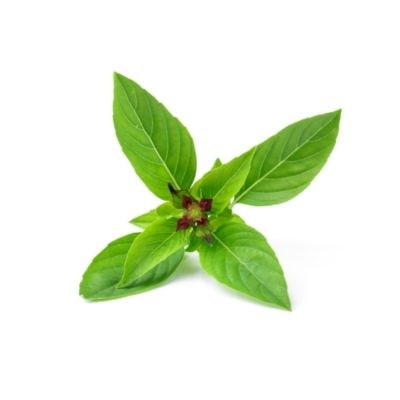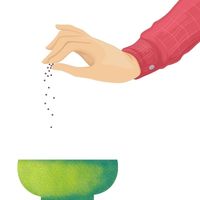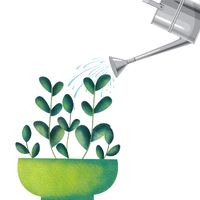
Botanical name : Ocimum basilicum horapha
Flavor Profile : Licorice anise mixed with sweet, spicy, peppery, and clove
Thai basil ( also locally known as ‘Bai Horapa‘ ) is used extensively in Southeast Asian cuisines beyond Thailand, such as Cambodian, Laotian, and Vietnamese. ‘Vietnamese pho’ (a staple Vietnamese dish) is always accompanied by a garnish dish containing lime wedges, bean sprouts, chili peppers, and Thai basil leaves.
Its distinct anise flavor differentiates it from its Mediterranean counterparts. Because of this flavor profile, it’s also known as licorice basil or anise basil.
Its leaves are more robust when compared to sweet basil, making it more tolerant to heat and therefore an ideal candidate for dishes that require a long cooking time, such as curries and soups. Thai basil also makes a lovely ornamental plant to grow in the home, thanks to its dark-green leaves and purple stems.
Health benefits of Thai Basil
Thai basil also has anti-inflammatory properties and can help relieve upset stomach and arthritis like sweet Mediterranean basil. As well as calcium, magnesium, and potassium, it is packed with vitamins A, C, and K. In addition to antibacterial, antiviral, anti-fungal and antioxidant properties, it can help prevent cardiovascular disease, relieve asthma symptoms, and treat common colds and flu.
How to grow Thai basil indoors
Thai basil can be grown successfully in containers indoors as a tropical perennial. Thai basil plant should be placed in a sunny window with adequate drainage.
Spring or early summer is the preferred time to sow the seeds. It can mostly grow in any climate.
Plant size

1 – 2 feet ( 12 -24 inch or 30 – 60 cm)
Container / pot Size

9 inches Diameter ( 22 cm ) or 2 gallons ( 7.5 liters )
Refer how to choose the right container for your indoor plants for more details
Sunlight

Full Sun. At lease 6 hours of sunlight is recommended for Thai basil plant. However, the plant can also tolerate partial shade indoors.
Place in a warm room. A small fan blowing away from the container can be used to provide ventilation if needed.
Refer Best locations and Light requirements for indoor plants for more details.
Soil

Fertile, moist, rich in organic matter and well drained Potting mix. Thai basil plant also prefers slightly acidic soil. For more organic matter you can add compost in the ration of 50:50. Potting mix:Compost.
Sowing

Can be sown by seeds or young plants from nursery. Sow the seeds any time. However, sowing the seeds after frost is advisable. Plant seeds 1/4th of an inch deep in the potting mix. As a thumb rule, you can sow the seeds in spring or early summer season.
Keep a distance of almost 8 inches between the two seeds. (you can also change this spacing based on your experience. Usually a spacing of 12 inches is recommended). It is important to ventilate Thai basil properly since it is susceptible to fungi. Avoid bunching of the the plants.
To graft or transplant, make an angled cut 6 inches below the leaf node with sanitized snips or a sharp grafting knife. The lower leaves of the cutting must be removed. Place the cutting in a jar with water. Changing the water frequently is necessary. Let the roots develop before transplanting the cutting into good quality potting soil.
Quick tip: Thai basil will start germinating in 7-10 days. You can start transplanting the Thai basil plant as soon as 2-3 small leaves (cotyledons) start appearing.
Watering

There are quite a few things to keep in mind when watering Thai basil. Thai basil thrives in damp, free-draining conditions. In wet or waterlogged soil, Thai basil quickly becomes infected with fungal diseases.
Thai basil needs plenty of drainage holes in the pot it is planted in, and it should be watered every two to three days. To make it simple, water the plant whenever the soil feels dry to the touch.
Refer How to make drainage holes on potting container for more details.
You can also protect your Thai basil from diseases by not wetting the leaves. Additionally, wet leaves will become yellow in the sun.
Quick tip: You should water the plant only around its base and not over its leaves. To prevent soil over-saturation, you can also spray water on the soil with a spray bottle.
Harvesting

Throughout the season, clip or gently pinch off the leaves as they mature. Take only a few sprigs from each plant at a time. You can start with those at the outer part of the plant and new ones will grow.
You should avoid removing the lower, woody sections of the stems. Make sure you harvest everything before the first fall frost.
Plant care

As soon as you see flowers, cut them to encourage new growth and avoid seeding. Take special care of the plant in frost conditions.
For a leafy crop, you can also apply an all-purpose liquid fertilizer to mature Thai basil plants every 2 weeks. However, if the potting mix is of good quality, this is an optional practice.
SUBSTITUTES FOR THAI BASIL IN THE KITCHEN
- Star anise
- Holy basil ( Tulsi )
- Basil with mint
- Mint
- Cilantro
How to keep Thai basil fresh
Dried Thai basil loses its flavor significantly, so it should not be dried.
You can store Thai basil leaves in oil. Or you can also freeze them in ice-cube trays.
Please refer to how to store herbs and spices for more details.
How to use Thai basil in the kitchen
Thai basil’s unique and strong anise flavor provides balance in spicy Asian stir-fries, rice, noodles, and curries.
Raw Thai basil pairs well with salads, spring rolls, and other cold dishes. Thai basil is even used in smoothies and ice-creams for an added herbaceous punch.
Dishes : Curries, soups, noodles, rice, salads, stir-fries.
Preparation : Used as whole leaves or can be torn into smaller pieces depending on the size and cuisine.
Pairing Thai basil with food
Seasoning : chili peppers, coriander seeds, lime juice, mints, Garlic, makrut lime, cilantro, Banise seeds, curry powder and paste, turmeric, fish sauce, lemongrass, tamarind, cloves, red pepper flakes, vanilla, galangal, lemon juice, soy sauce, ginger, cumin.
Fruits and Vegetables : Mushrooms (Enoki Mushroom, Morel Mushroom, White Mushroom / Button mushroom, Cremini Mushroom, Portabella Mushroom, Shiitake Mushroom, Maitake Mushroom, Chanterelle Mushrooms, Oyster Mushroom), celery, baby corn, zucchini, potatoes ( White Potato, Red Potato, Russet Potato, Purple Potato ), eggplant, green beans, radishes, cabbage ( red cabbage, green cabbage ), mango, pineapple, carrots, bamboo shoots, tomatoes, snap peas, bean sprouts, scallions, broccoli.
Proteins : Chicken, tofu, fish and seafood, cashews, peanuts, duck, beef, eggs, pork


